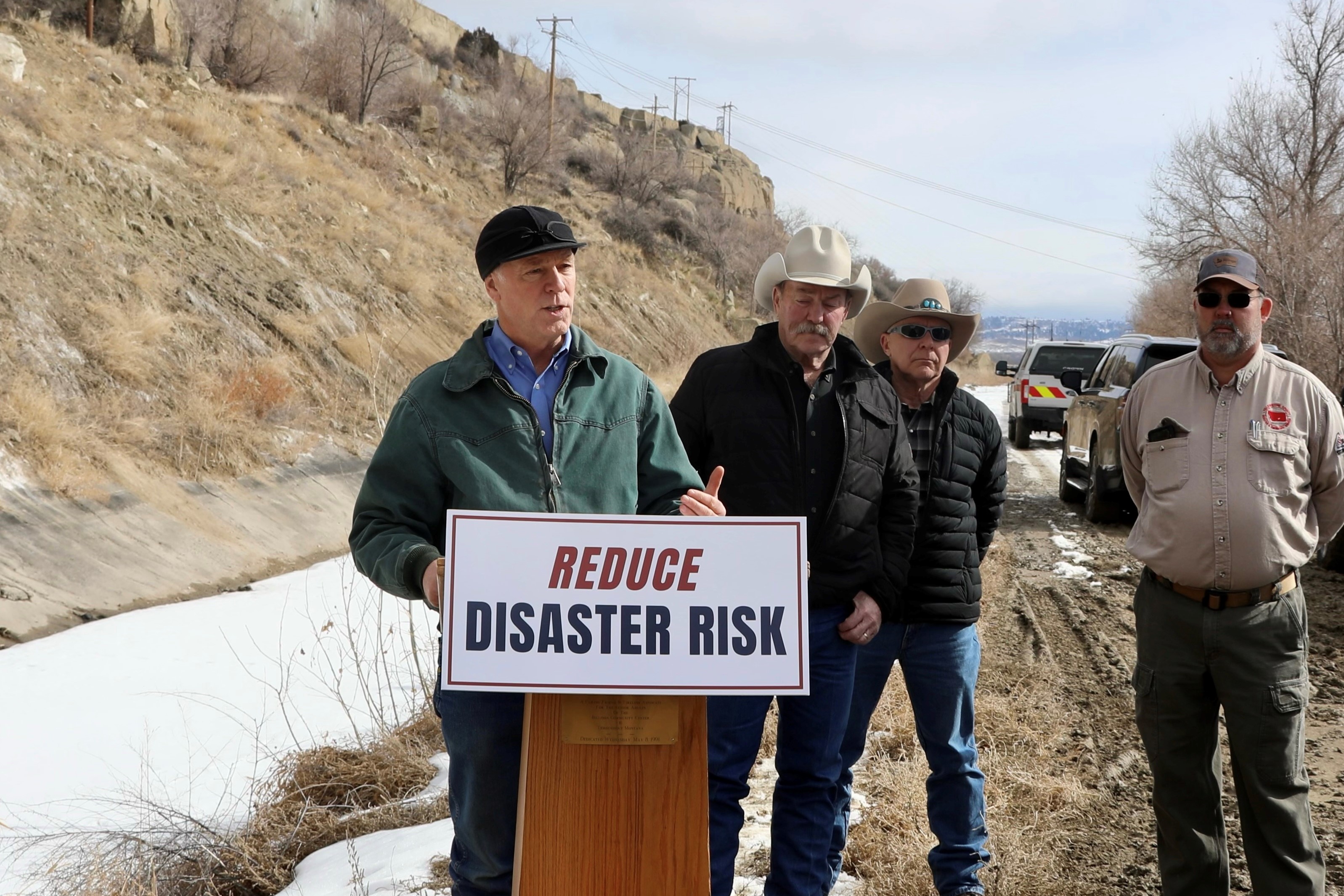Governor Gianforte, Local Officials Urge Legislators To Pass Local Disaster Resiliency Fund
Governor also urges legislators to pass tax relief, critical investments
BILLINGS, Mont. – As the Montana Legislature approaches its transmittal break, Governor Greg Gianforte traveled to Yellowstone County today to discuss Montanans’ priorities, including investments in local disaster resilience and tax relief.
“Montanans sent us to Helena to deliver on their priorities,” Gov. Gianforte said. “In talking with folks in Yellowstone County today, it’s clear they’d like to see tax relief and the legislature act to invest in local disaster resilience.”

Standing beside the BBWA irrigation ditch, Gov. Gianforte and Yellowstone County officials address the need for the local disaster resiliency fund
The governor joined Billings Mayor Bill Cole, Yellowstone County Commissioners John Ostlund and Mark Morse, and Disaster and Emergency Services (DES) officials to survey the Billings Bench Water Association (BBWA) irrigation ditch. At risk of slope failure, the nearly 120-year-old canal system runs more than 60 miles and serves approximately 1,500 customers.
The proposed local disaster resiliency fund, which the governor introduced in his Budget for Montana Families and which Rep. Larry Brewster, R-Billings, is sponsoring in legislation, provides funding to support local disaster mitigation projects, like the BBWA irrigation ditch which could cost $25 million to repair.
Emphasizing the need to establish the fund in law, KC Williams, Yellowstone County Director of Emergency and General Services, said, “If we don’t fix this, we run a real risk of losing lives.”
The $100 million local disaster resiliency fund will support state and local projects that reduce or eliminate long-term risk to people and property from future disasters, leveraging state dollars for up to a 9-to-1 federal match.
“As the old saying goes, an ounce of prevention is worth a pound of cure,” Gov. Gianforte said. “With just one state dollar, we can secure nine federal dollars to invest in disaster mitigation. We could use $2.5 million from our local disaster resiliency fund to leverage another $22.5 million from the federal government. It’s just common sense.”
The National Institute for Building Sciences found that for every dollar invested in disaster mitigation, it saves an average of six dollars over the life of the project.
Rep. Brewster’s bill to establish the local disaster resiliency fund, House Bill 269, passed the House State Administration Committee and the House of Representatives on second reading in early February.
Legislators on the House Appropriations Committee, however, tabled the bill on February 15.
Local officials joined the governor in calling on legislators to reconsider the proposal and its impacts and to pass the bill.
“Disaster mitigation is an enormous priority for us, and focusing on these projects is a fundamental component of that,” said Yellowstone County Commissioner John Ostlund. “It’s important folks call their legislators to tell them this is a critical bill that requires immediate action.”
Billings Mayor Bill Cole added, “A breach or blockage of this ditch would be a truly catastrophic event that might endanger many lives and hundreds of millions of dollars of property located downhill from the ditch. That’s why it’s so important that the BBWA, in partnership with the city, county, and state, look for ways to make sure that this ditch can continue to safely transport water through the middle of our community for the next hundred years.”
“Failing to establish the local disaster resiliency fund would be a dereliction of duty. Failing to get this done would risk millions of dollars of damage, just here in Yellowstone County,” Gov. Gianforte said. “I again ask legislators, ‘Is it worth the gamble?’ I don’t think so.”
The governor also addressed his proposal for the largest tax cut in Montana history, which would deliver $1 billion in immediate rebates and permanent, long-term relief for Montanans at every income level.
In Yellowstone County alone, the governor’s individual income tax cut proposal would return over $45 million to taxpayers at every income level.
“We’re making progress with the legislature,” Gov. Gianforte said, “but our work is not done.”
Gov. Gianforte urged legislative action on his permanent, refundable $1,200 child tax credit for lower-income and middle-class Montana families. After the House Bill 268 passed the House Taxation Committee and the House of Representatives on second reading, the House Appropriations Committee tabled the pro-family tax cut measure last week.
“With prices skyrocketing, it’s harder for Montanans to make ends meet, especially for Montana parents who are raising their young kids. Our Budget for Montana Families proposes a $1,200 child tax credit to help families with the cost of raising their younger children, including health care, child care, food, clothing, and diapers,” Gov Gianforte said. “A child tax credit strengthens families and empowers parents, especially working mothers. The child tax credit is historically a very conservative idea – pro-family, pro-child. President Trump expanded the federal child tax credit with his tax cuts in 2017.”
Gov. Gianforte continued, “If you think Montana should support middle class families with younger kids, call your legislators and tell them to move forward with the child tax credit. We need to get all these bills across the finish line. Montanans need tax relief. There’s no time to wait. Let’s get it done.”
Providing historic tax relief and making needed repairs are two pillars of Governor Gianforte’s Budget for Montana Families. After giving over $1 billion back to Montana taxpayers, the governor’s budget invests the state’s surplus to repair infrastructure and state facilities, save for emergencies, and pay off all general obligation debt to make Montana debt-free in 2023, saving taxpayers $40 million over the next two years.
“We have a real opportunity here to make a generational difference. Let’s get this done,” the governor concluded.
###